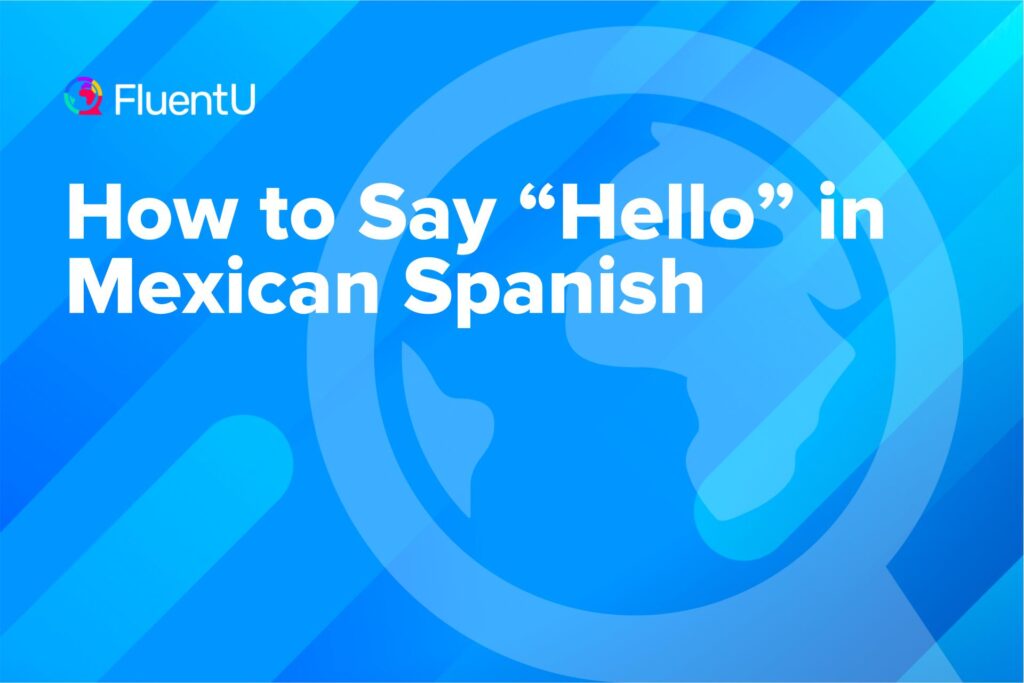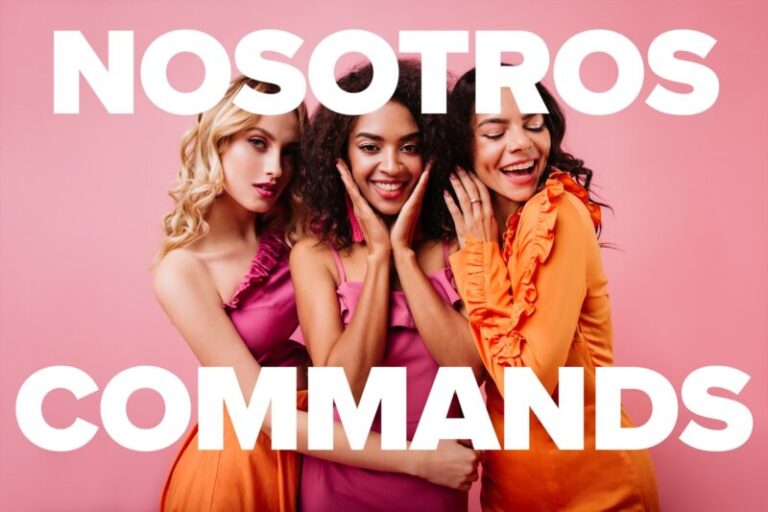How to Say “Hello” in Mexican Spanish

There are stacks of ways to say “hello” in Spanish—and they’re not the same across every Spanish-speaking country.
With nearly 130 million people calling Mexico their home, Mexican Spanish is the most widely spoken variant in the world, and it has some pretty unique slang. To get good at Mexican Spanish, the first step is learning how to say hello like a local.
Download: This blog post is available as a convenient and portable PDF that you can take anywhere. Click here to get a copy. (Download)
Formal Greetings in Mexican Spanish
So, let’s start with the basics.
Some of the first words you’ll say to most people when you meet them are buenos días (good morning). It’s a polite and universal greeting that works with anyone.
This greeting changes according to the time of day, so you would use buenos días (good morning) until noon, buenas tardes (good afternoon) between noon and sunset and buenas noches (good night) after sunset.
Notice how the adjective buenos (good) changes to agree with the number and gender of the noun it describes.
When it comes to meeting people in a formal situation in Mexico, there are some key tips and vocabulary to remember:
1. Use usted (formal version of you)
Like in castellano (the Spanish spoken in Spain), usted is very important to show respect. Use it to address a person who you don’t know, who is older than you or who is in a position of authority over you.
So, let’s say you’re at a university and you’re introduced to one of the professors. A university professor is likely to fall into all three categories, so you’d definitely call him or her usted.
Here’s an example of how to greet them:
¡Hola! Qué gusto conocerlo.
Hello! What a pleasure to meet you.
Note: Conocerlo is used when you’re speaking to a man. To a woman, you’d say, “Qué gusto conocerla” (what a pleasure to meet you). This is because the direct object pronoun lo/la has to agree with the gender and number of whomever you’re talking to.
2. Use Señor(a) (Mr./Mrs.) instead of the person’s first name
For anyone who you’d normally call usted, it wouldn’t be polite to address them using their first name. Always call them Señor / Señora until they invite you to use their first name.
For example:
Hola, señor Ruíz. ¿Cómo le va?
Hello, Mr Ruíz. How’s it going?
If you know the person has a profession, replace señor(a) with their title:
Buenos días, profesor González.
Good morning, Professor González.
Perfect.
Now, let’s say you’re looking for someone you’ve not personally met before, and you need to check if you’re speaking to the right person. In this case, you’d say:
Disculpe, ¿es usted la doctora García?
Excuse me, are you Dr. García?
Disculpe (excuse me — formal) is a super useful word, as it can be used in any situation with an adult you don’t know. When talking to someone your own age or younger, disculpa (excuse me — informal) is the less formal option.
3. Formal vocabulary for meeting new people
¿Cómo está?
How are you?
Muy bien, ¿y usted?
Very well, and you?
¡Que tenga un buen día!
Have a great day!
Mucho gusto en conocerlo
/ conocerla.
Nice to meet you. (male / female acquaintances)
Igualmente.
Likewise.
Que le vaya bien.
Have a nice day!
¡Adiós!
Goodbye!
4. Always shake hands!
It’s a cultural expectation that when Mexicans meet each other to spend time together (i.e. anything more than a brief passing), they have some kind of physical contact.
Formal introductions are no exception. Alongside your greeting, make sure you include a handshake if you call the person usted (you — formal). Shake hands when you leave as well.
Here’s a top tip: if you’re introduced to a room full of people, greet and shake hands with each person individually. Greeting the group as a whole would seem rude.
Informal Greetings in Mexican Spanish
Informal chat is where Mexican Spanish comes into its own. You’ve probably heard many Mexican slang terms from TV shows or movies!
Since Mexican greetings can range from being extremely formal to funny and casual, knowing when to say them is important. You can learn when to use them by familiarizing yourself with Spanish media, or using a language learning program like FluentU. This program allows you to learn words and phrases in context, with Mexican slang and regional expressions included, too.
FluentU takes authentic videos—like music videos, movie trailers, news and inspiring talks—and turns them into personalized language learning lessons.
You can try FluentU for free for 2 weeks. Check out the website or download the iOS app or Android app.
P.S. Click here to take advantage of our current sale! (Expires at the end of this month)

To start with, here are some phrases you’ll need when meeting friends of friends, friends’ family members or pretty much anyone in a casual setting:
1. Use tú with friends, family and people you know
As we know, tú is the informal way to address people in Spanish, and this is true in Mexico as well. Use it for any casual, informal situation—think meeting people at a party, making friends in a cantina (bar) or any situation where there’s no sense of hierarchy among people.
Here are some examples of tú (you — informal) forms in action. Why not compare them to the usted (you — formal) versions earlier?
¡Hola! Qué gusto conocerte.
Hi! What a pleasure to meet you.
Oye, Juan. ¿Cómo te va?
Hey, Juan. How’s it going?
¿Cómo estás?
How are you?
Muy bien, ¿y tú?
Very well, and you?
¡Que tengas un buen día!
Have a great day!
Mucho gusto en conocerte.
Nice to meet you.
Igualmente.
Likewise.
Que te vaya bien.
Have a nice day.
2. Additional informal phrases
Why not add a couple of bonus phrases to your vocabulary list?
Cuídate.
Take care of yourself.
¡Nos vemos!
See you soon!
So now that you’ve made some Mexican friends, you can greet them with several Mexican slang phrases the next time you see them. Let’s learn some!
The most popular is ¿qué onda? (what’s up?), to which they might respond aquí nomás (just chilling) or nada, todo tranquilo (all’s good).
If everything’s also going well with you, you could reply with también aquí (same here).
Just like in English, there are a ton of different ways to say “what’s up” in Mexican Spanish. Here are just a handful:
¿Qué tranza?
What’s up?
¿Qué rollo?
(Similar to the Irish phrase “What’s the craic?”)
¿Qué hay de nuevo?
What’s new?
¿Qué cuentas?
What’s new?
Why not practice some of these the next time you’re at a party in Mexico?
3. Mexican slang words for your friends
Mexican Spanish is full of affectionate phrases for friends. Perhaps you’ve heard of some of these:
It’s perfectly normal to hear friends greeting each other using these terms. Here are a couple of examples of how you might hear them:
Oye, carnal, ¿qué hay de nuevo? (Hey brother, what’s new?)
Hola güey, ¿qué onda? (Hey dude, what’s up?)
4. Friendly gestures like handshakes and air kisses
Like with formal interactions, when you’re meeting someone for more than a brief “hello,” there will be a form of physical contact to accompany it.
In informal situations, this can look different depending on the gender of the person you’re meeting.
Men greet other men with a firm handshake. Close male friends or family members might also hug each other after the handshake.
When female friends or family members greet other women, they give each other an air kiss (besito) on the right cheek. Men and women greeting each other also use air kisses.
So, with this in mind, there won’t be any more awkward moments where you’re deciding whether to kiss someone or shake their hand!
Now to put your newfound greeting skills to the test.
Mexico is a friendly place. One of the most interesting parts of living in Mexico is how people greet each other every time they pass in the street, even if they run into each other multiple times a day!
It’s considered rude not to greet someone you walk past. If you can’t stop to chat, greet the other person with a quick “Adiós” (goodbye) and they’ll know that you’ve got somewhere to be.
Remember, even a quick stroll around a Mexican village can lead to lots of opportunities to say hello.
Download: This blog post is available as a convenient and portable PDF that you can take anywhere. Click here to get a copy. (Download)
And One More Thing…
If you've made it this far that means you probably enjoy learning Spanish with engaging material and will then love FluentU.
Other sites use scripted content. FluentU uses a natural approach that helps you ease into the Spanish language and culture over time. You’ll learn Spanish as it’s actually spoken by real people.
FluentU has a wide variety of videos, as you can see here:

FluentU brings native videos within reach with interactive transcripts. You can tap on any word to look it up instantly. Every definition has examples that have been written to help you understand how the word is used. If you see an interesting word you don’t know, you can add it to a vocab list.

Review a complete interactive transcript under the Dialogue tab, and find words and phrases listed under Vocab.

Learn all the vocabulary in any video with FluentU’s robust learning engine. Swipe left or right to see more examples of the word you’re on.

The best part is that FluentU keeps track of the vocabulary that you’re learning, and gives you extra practice with difficult words. It'll even remind you when it’s time to review what you’ve learned. Every learner has a truly personalized experience, even if they’re learning with the same video.
Start using the FluentU website on your computer or tablet or, better yet, download the FluentU app from the iTunes or Google Play store. Click here to take advantage of our current sale! (Expires at the end of this month.)







